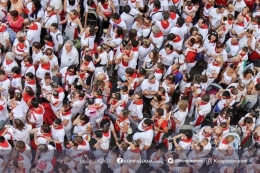As a very broad term in which many things are included, Islamic art generally refers to the art produced by Muslims from the time when Islam first spread out of Arabia in the 7th century to the height of the Ottoman Empire in the 16th century.
In an attempt to belittle the efforts and achievements of Muslims throughout history, some historians claim that there is no such thing as “Islamic Art” and that the art of the Islamic empire is taken from the nations conquered before like the Romans, Greeks, and Persians.
Everything from Islamic architecture, calligraphy, pottery, glass, and textiles are regarded as a form of Islamic art. Here are some examples of Islamic art and how they have impacted the world today:
Carpets & Rugs
The most iconic and popular forms of Islamic art are the carpets and rugs produced in the Middle East and Asia. Little evidence is available on the designs of carpets predating the 16th century, as hardly any survive today, There is, however, evidence in the Renaissance paintings which have accurately portrayed the carpets which were imported from the East. There was a high demand for Islamic carpets in Europe throughout history; the same quality and calibre of carpets just weren’t produced in the region and it was a symbol of wealth and prestige to own one of these lavish carpets.
The design of the carpets depended on the region that they were from, The discovery of an Egyptian carpet dating back to the 16th century (found in the attic of the Pitti Palace in Florence) featured a design of octagonal roundels, stars, and other complex patterns that appeared to shimmer. The Mamluks of Egypt were the first to produce this style of carpet; later, when the Ottomans conquered Egypt, they too continued the production.
Alongside Egyptian carpets, another famous variety was Persian carpets. During the 16th and 17th centuries, both the Ottoman and Mughal Empires (both were Muslim empires, one based in Turkey, the other based in India) commissioned Persian carpet makers to design intricate carpets for the palaces. After realising their talent and understanding the demand for such carpets, the carpet makers began to sell to the nobles and the wealthy.
Since the depiction of animate beings in Islam is forbidden as only Allah has the right to construct life, most Islamic carpets feature geometric design and complex patterns without images of living things. Some Muslims who didn’t interpret the religious texts this way have depicted animals on their carpets, but generally, this isn’t the case with the majority.
Calligraphy
There are some languages in the world that, when written in a certain style, look highly decorative. Alongside Chinese and Japanese scripts, one language that stands out in its calligraphic form is Arabic, especially when inscribed or painted in a beautiful colour such as green or gold.
Although calligraphy existed in Arabia before Islam, on a much smaller scale, the revelation of the Qur’an plus the invention of paper shortly after meant that scribes could practice their calligraphy on a cheaper medium, unlike parchment and papyrus, which were expensive, and they could also spiritually benefit from this. Certain verses in the Qur'an, such as “Ayat Al-Kursi” or “Surah Mulk“ and “The Verse of the Throne,” can ward off evil, and this, among other verses and words, became the central focus of Muslim calligraphers during the Islamic Empire and even today.
Another focus of calligraphers during the Islamic Golden Age was the 99 names of Allah. Since Muslims are forbidden to depict God as the human mind cannot comprehend Him, Muslims use the 99 names of Allah to know His attributes. Some of the names of Allah include “The Most Merciful” and “The Most Gracious”, and these names in their Arabic form are used to decorate mosques and ornamental objects.
Without understanding the meaning but falling in love with the design, Europeans tried to imitate Arabic calligraphy, either known to them through trade or from souvenirs brought back by pilgrims to the Holy Land. Interestingly enough, a cross dating back to the 9th century found in Ireland bears the Arabic inscription “Basmallah” (Bismillah), meaning “In the name of Allah”.
Follow Instagram @kompasianacom juga Tiktok @kompasiana biar nggak ketinggalan event seru komunitas dan tips dapat cuan dari Kompasiana. Baca juga cerita inspiratif langsung dari smartphone kamu dengan bergabung di WhatsApp Channel Kompasiana di SINI







